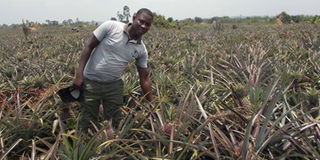Muyombya asks for fruit processing plant

Robert Muyombya examines pineapples in his farms. Photo by Michael J Ssali
What you need to know:
During harvest season, Robert Muyombya harvests between 10,000 and 20,000 pineapples. Every day, he loads two trucks of the fruits and exports them to Kenya, writes Michael J Ssali
Robert Muyombya is both a pineapple farmer and trader. Seeds of Gold caught up with him last week at his pineapple farm of 43 acres located at Mijunju Village, Kabira Sub-county, Kyotera District.
“This is only one of my many pineapple farms. I have farmed and traded in pineapples all my adult life,” Robert said.
Aged 32 years now, Muyombya has been in the pineapple business for nearly 15 years. As he disclosed, nowadays he loads two or three trucks of pineapples headed for Nairobi, Kenya every day.
“I have heard about government plans to set up a fruit processing factory in this part of Masaka but we all wonder when this will finally happen,” he told Seeds of Gold. “It has to be big enough to take on the big amount of fruits produced in the area ---- pineapples, tomatoes, mangoes and passion fruits.”
It was not so easy interviewing him for this story because almost every two minutes the young businessman, who carries three phones, receives a call.
The phone calls are mostly from his employees on his other farms in Masaka and Kyotera districts or the farmers from whom he buys pineapples and fellow traders.
“I don’t normally allow journalists to visit my farms because the radios and newspapers give the government the false idea that farmers are making a lot of money,” he said.
“Based on the misleading information the government imposes heavy taxes on the farmers by increasing the prices of agricultural inputs, which has made farming so unprofitable these days. Please make sure that you write the truth and tell government that it is strangling its farmers with taxes and making our work difficult.”
Fertilisers
He said that because of the high cost of fertilisers he has been forced to reduce their usage.
“These days, as you can see, we apply fertiliser only on one side of a raw of pineapples where we applied it on both sides before. Then I have to worry about herbicides which have become so expensive.” Muyombya who employs some 20 people on this farm, disclosed that it would be impossible to keep weeds under control using human labour.
“We have to use selective herbicides which have become so expensive. Labourers are also a big issue because some of them desert work without warning. It is the reason that often when I am asked how many people I employ on this farm I just say between 16 and 20. ”
How he started
He had to leave school after Primary Six due to school fees problems and he spent some two years of apprenticeship under a local builder.
“I tried out a small garden of pineapples on borrowed land and I found it more paying than building.” He then got into the practice of hiring pieces of land and growing pineapples. “In the beginning I used to do the digging myself but as the business became bigger I resorted to employing people. With time I became friendly to the traders who used to buy my pineapples. They began to trust me with their money and to ask me to book pineapples for them from established farmers. It turned out that I was like their contact person in the area --- someone who knew which farmer had the best pineapples and which buyer offered the best prices. That is how I ended up becoming a pineapple trader and a farmer at the same time. I owe it to honesty and reliability.”
To get maximum returns, the farmer advises that one must dig a one-and-half feet hole, add manure and mix it with soil and fertiliser, and leave it open for about two weeks and then plant the suckers.
Costs
Pineapples now cost between Shs2,000 and Shs3,000 at farm gate price. A farmer may harvest up to 10,000 pineapples from an acre annually.
He has once in a while had to borrow money from Micro-finance Support Centre and he says paying back the loans has been quite easy.
“I never take a loan without a payment plan in place,” he said. “I always make sure that there are pineapple fields from which I keep harvesting and selling.”
The farmer and his family live in their own house in Masaka Nyendo/Senyange Division in Masaka Municipality and he regularly drives in a personal car to his various pineapple fields to do supervision.
After good ground preparation the farmer plants pineapple suckers about two feet from one another in a line and about three feet between lines. The farmer may apply fertilisers between the lines depending on the soil nutrient requirements.
Muyombya said pineapples have no serious pest issues.
He also said the crop does not encourage intercropping.
Expands farm
Today he has perhaps a total of 90 acres of pineapple on the different small farms but his dream is to own 200 acres all on one piece of land. So far all his farming is done on hired land.
He likes growing pineapples because, as he said, the crop does not require irrigation even when there is rain shortage. It takes about 18 months to see the first fruits after planting and the farmer may continue harvesting pineapples for close to three years.
He said the crop has a way of trapping and storing rainwater with its leaves and then absorbing it without using its roots although they also take in water. Its leaves are created to retain water as much as possible. It is the reason the fruit has a lot of juice.




